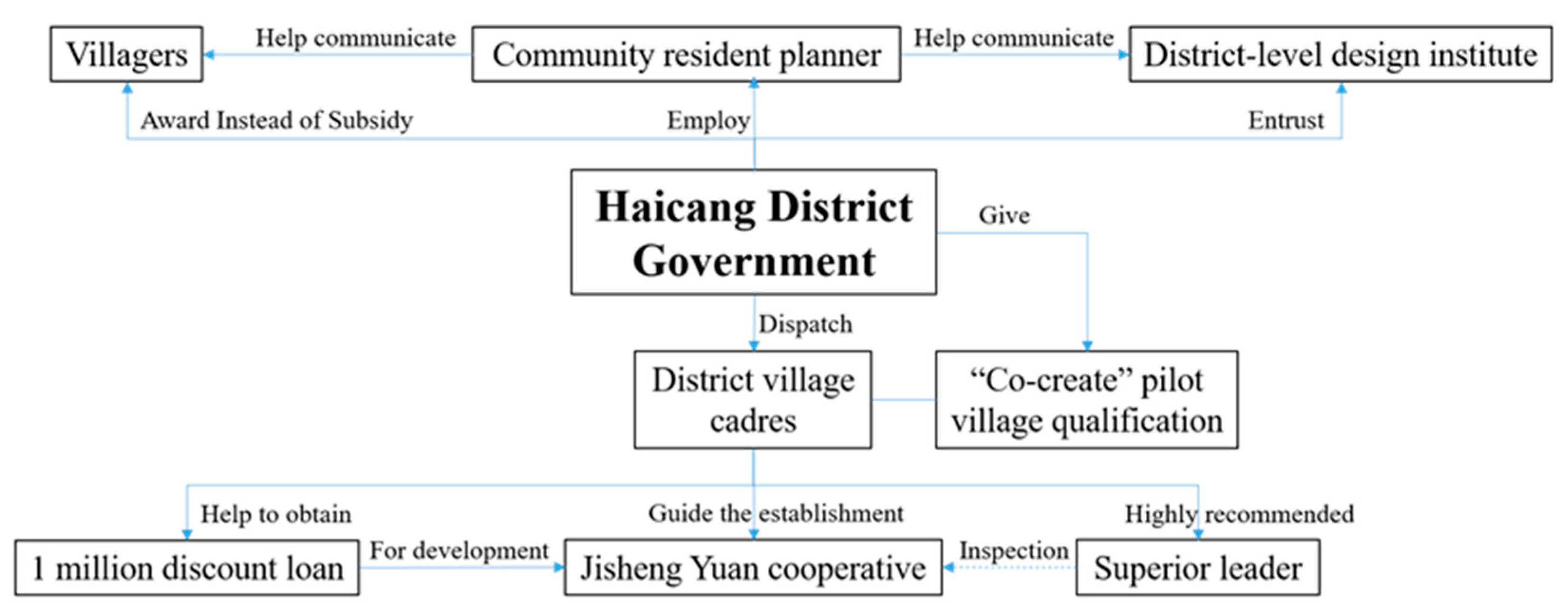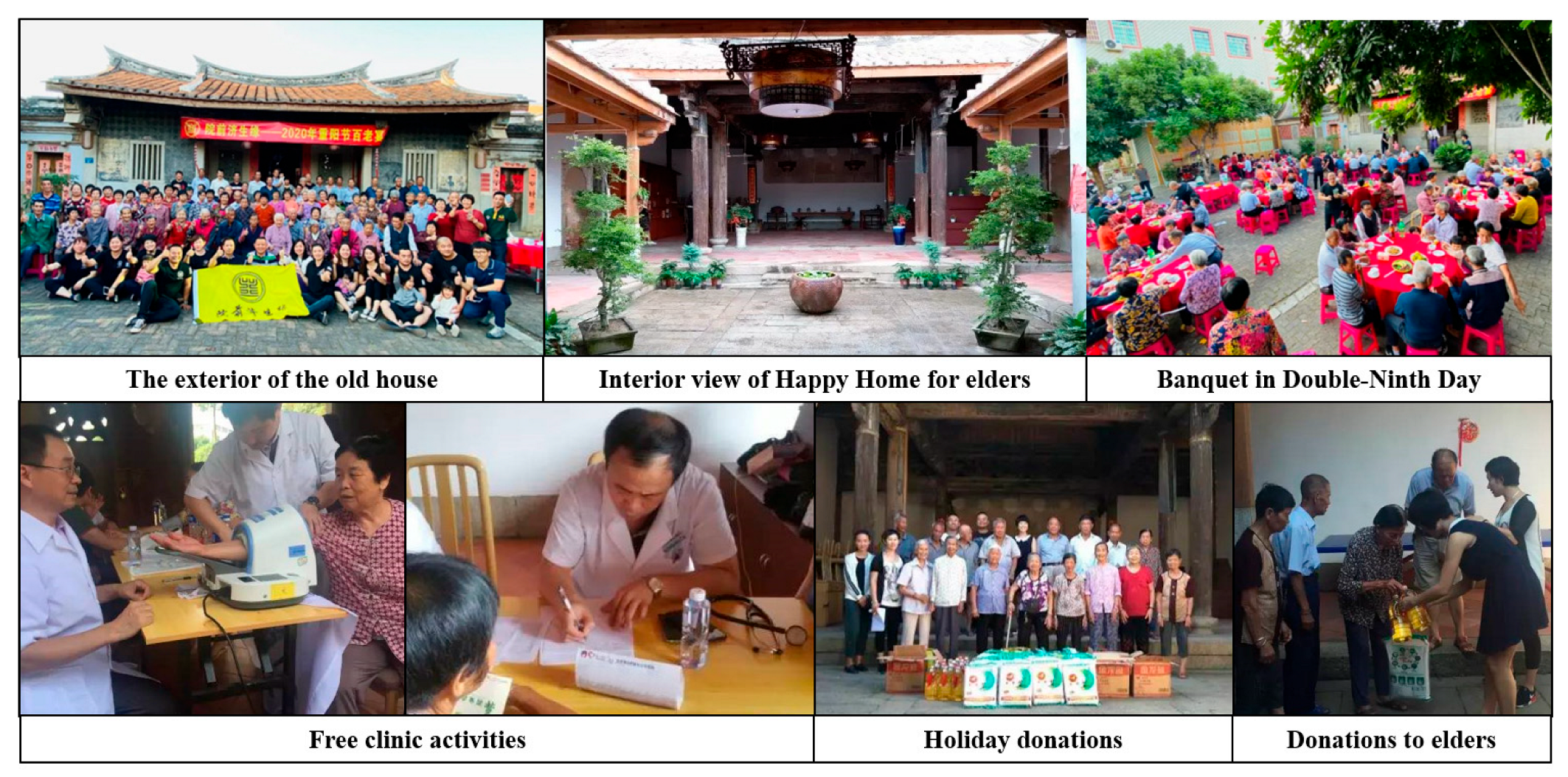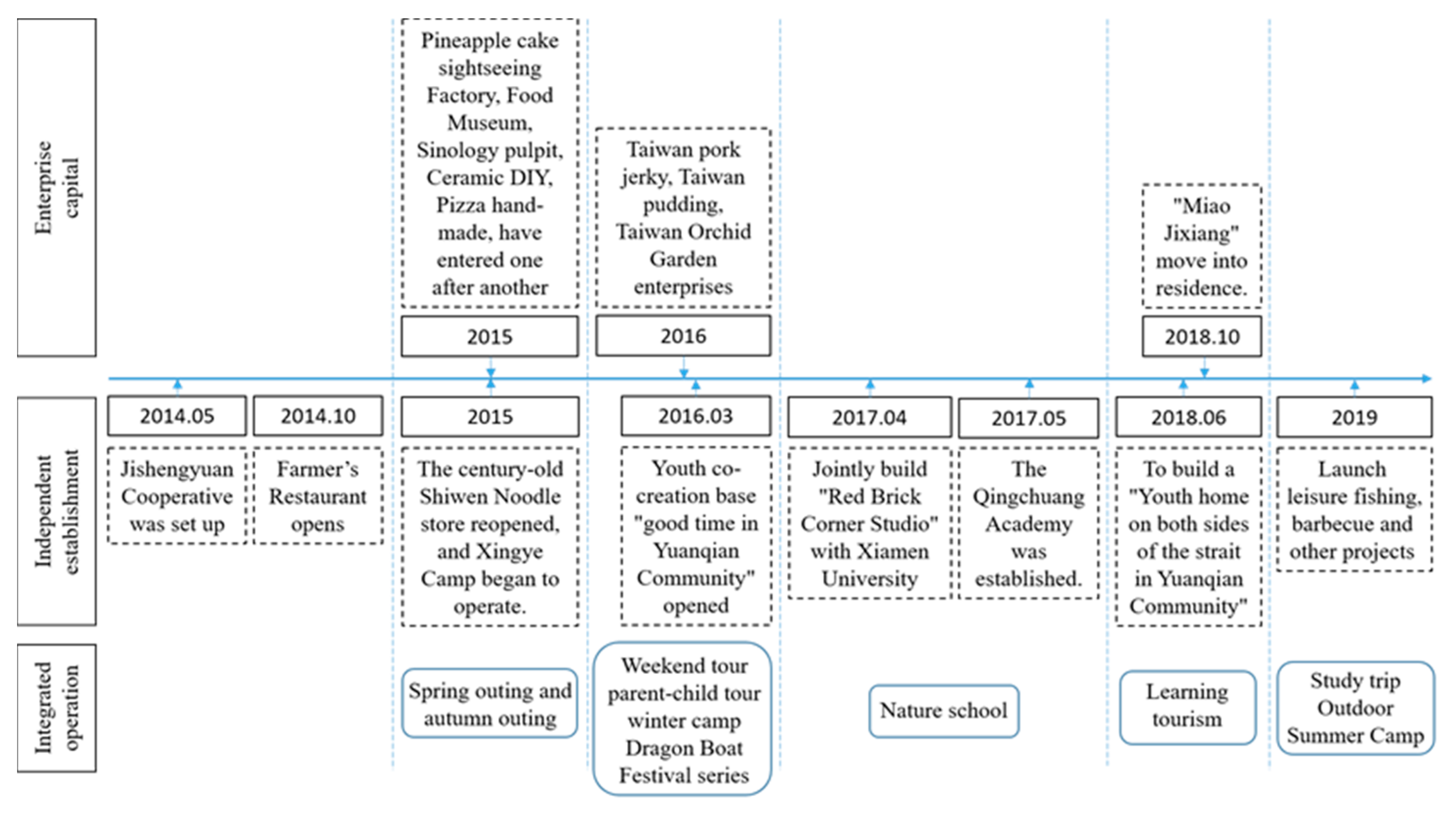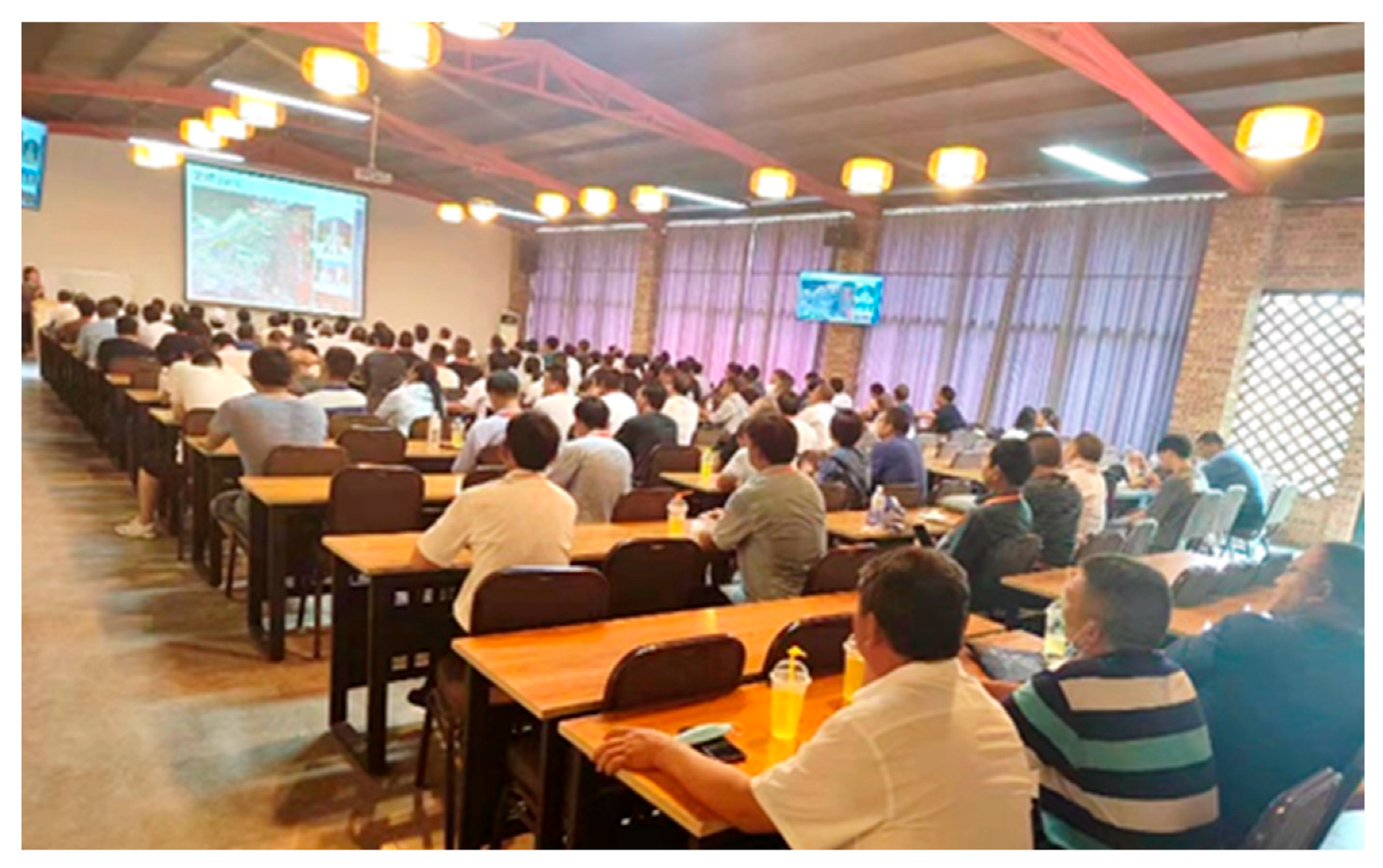Sustainable Endogenous Development Path Based on Rural Local Elite Governance Model: A Case Study of Xiamen
Abstract
:1. Introduction
2. Literature Review
3. Methodology
4. Summary of the Development Stage of the Yuanqian Community
4.1. Apply for Pilot Village Qualification
“This is our root; no one wants to see their village torn down. I come back for the Spring Festival every year. If the village is torn down, I can’t find a place to remember my childhood memories. Homesickness is gone. What’s the point of coming back? Therefore, seeing that the government has started the ‘Co-creation’ project, I want to seize this opportunity to fight for the village. I wonder if our village will not have to be torn down if it becomes so beautiful.”
“The villagers put in work, labor, and money for construction, mainly to sort out the space in front and back of the house, to take the initiative to sell land, and so on. All labor and land occupation costs generated by this part are converted to 40% of the investment amount. 40% of the early investment was mainly completed by the two village committees and the early team of Jisheng Yuan cooperative. In the later stage, the district government made 60% of the investment to purchase raw materials, and the two village committees organized and hired self-organized construction teams in the village to complete the remaining infrastructure construction. The construction team was founded by the original shareholders of the Jishengyuan cooperative, but the construction team itself was not directly related to the later cooperative.”
4.2. “Co-Creation” Begins
“Seeing that my hometown is implementing ‘Co-creation,’ I also want to make a contribution. As soon as the work of the company was finished, I immediately came back to the village to help.”
“The design of the facilities in the village can be based on our own opinions and feel that we are part of it. Look, the flower bed at my door was built according to my idea.”
“The factory is at the entrance to the village. As long as you can see the old factory building as soon as you enter the village, the image of the village is obviously reduced. I also hesitated for a long time, but for the future development of the village, I can no longer keep the factory.”
“At that time, I thought that I was the only one who had come back from the city, but I did not expect that there would be many young people in the village, which made me have more confidence in going back to my hometown to start a business.”
4.3. Jisheng Yuan Cooperative Established
“There used to be a popular social network game called “Happy Farm,” I thought, why can’t we also set up a farm in the Yuanqian Community? The Yuanqian Community is so close to the city that the project may be successful. Moreover, the surrounding villages are doing “Co-creation.” We have to do something different to attract people. Unexpectedly, the idle young people in the village actively participated in the project. They arrived at the vegetable field at 6 a.m., and they were all white and tender, and soon they were tanned even darker than me. Who would want to leave home if there is an excellent opportunity to start a business?”
“We usually bring our children here on weekends to experience farming, and we can harvest almost 250 kilograms of pollution-free vegetables a year. Today, there is also a big harvest. He feels very fresh when the children see pineapples grow from the soil.”
“The environment here is good, close to Taiwan, the climate and living habits are similar, and they have the same origin. And here, it is full of human feelings, and the villagers naturally get along with us. There is no estrangement.”
5. The Process of Empowerment of Local Elites
5.1. Empowering Process
5.1.1. Administrative Empowerment
“Xiamen City has launched the ‘Beautiful Xiamen Strategic Planning’, in which ‘Co-creation’, similar to Taiwan’s ‘Community-Building’ mechanism, is taken as the primary operation method of rural development. I followed the team to Haicang District. Then, the village in charge was the Yuanqian Community. The Yuanqian Community was designated as a demolition village a long time ago. Still, when our team went in to do research, we found that there were as many as 39 ancient houses in the Ming and Qing dynasties, and there were a lot of cultural stories to tell. Therefore, I want to import the mode of rural tourism and let the Yuanqian Community out of the fate of being demolished. On the one hand, I choose to stay in the Yuanqian Community because there are many opportunities on the mainland, and the professional stage is relatively larger. On the other hand, it is because there is a great sense of intimacy and courtesy to Taiwanese compatriots, and the villagers have never rejected me.”
5.1.2. Social Empowerment
5.1.3. Economic Empowerment
5.2. Reconstruction of Rural Governance Network
6. Rural Sustainable Endogenous Development Path
6.1. The Transformation of Rural Space
6.1.1. Renovation of Cultural Space
6.1.2. Increase Consumption Space
6.1.3. Construction of External Publicity Space
6.2. Rural Industry and Sustainable Endogenous Development Path
7. The Expansion of the Scale of Village Influence
7.1. The Changing Process of Influence Scale
7.1.1. The Formation of a Typical Village for “Co-Creation” on the City Level
7.1.2. Rural Revitalization of Typical Villages on a National Scale
7.1.3. Brand Spillover of “Yuanqian Experience”
7.2. Replicable Operation Mode
8. Discussion and Conclusions
8.1. Discussion
8.2. Conclusions
8.2.1. Local Elites Reconstruct the Rural Governance Network
8.2.2. Local Elites Governance Network Promotes the Formation of an Endogenous Development Path
8.2.3. China’s “Co-Creation” Is an Important Part of the Practice of International Community Participatory Governance
Author Contributions
Funding
Institutional Review Board Statement
Informed Consent Statement
Data Availability Statement
Conflicts of Interest
References
- Xu, J.Y.; Li, T. Regeneration of Decayed Villages in Exurban Zone: Lianma Village, Guangzhou. Planners 2018, 34, 96–101. [Google Scholar]
- Zhang, Q.; Zhang, H.C.; Liu, Z.F. Rural Revitalization: Strategic Choice from Decline to Revival. Econ. Manag. 2018, 32, 6–11. [Google Scholar]
- Ye, C.; Pan, J.W.; Liu, Z.M. The historical logics and geographical patterns of rural-urban governance in China. J. Geogr. Sci. 2022, 32, 1225–1240. [Google Scholar] [CrossRef]
- Xi, J.P. Secure a Decisive Victory in Building a Moderately Prosperous Society in All Respects and Strive for the Great Success of Socialism with Chinese Characteristics for a New Era: Delivered at the 19th National Congress of the Communist Party of China; People’s Publishing House: Beijing, China, 2017. [Google Scholar]
- Zheng, Y.H. On the Cultivation of Village Elite and the Construction of Rural Community Culture: From the perspective of authority and order. J. Ningbo Univ. 2009, 22, 112–116. [Google Scholar]
- Dang, G.Y. Review and Prospect of Rural Governance Reform in China. Soc. Sci. Front 2008, 31, 1–17. [Google Scholar]
- Wang, X.Y. Rural Public Affairs and Rural Governance. J. Jiangsu Adm. Inst. 2016, 16, 54–60. [Google Scholar]
- Zheng, W.D. The Transformation of “Dual Track Politics” and Governance Structure Innovation in Chinese Villages. Fudan J. (Soc. Sci.) 2013, 55, 146–153+159–160. [Google Scholar]
- Lu, X.Q. The Imperial Power Permeating Below the County-level: The Township-Village System in Ancient China and Its Es-sence. J. Peking Univ. (Philos. Soc. Sci.) 2019, 56, 74–86. [Google Scholar]
- Biao, L.L.; Liu, Z.H. Invigorating the Countryside with Talents. People’s Forum 2019, 27, 72–73. [Google Scholar]
- Deng, D.C. The Choice of the Basic Units of Rural villager Autonomy in China: Historical Experience and Theoretical Con-struction. Study Explor. 2016, 38, 47–59. [Google Scholar]
- Jin, T.J. A Political Sociological Analysis of the Interaction of Triple Power in Village Governance. Strategy Manag. 2002, 10, 105–114. [Google Scholar]
- The CPC Central Committee Issued the Communist Party of China Regulations on the Work of Rural Grass-Roots Organizations. Available online: http://www.qstheory.cn/yaowen/2019-01/11/c_1123974517.htm (accessed on 30 March 2023).
- Organic Law of the People’s Republic of China on Villagers’ COMMITTEES. Available online: http://www.npc.gov.cn/npc/c30834/201901/188c0c39fd8745b1a3f21d102a57587a.shtml (accessed on 30 March 2023).
- Ye, C.; Ma, X.Y.; Chen, R.S.; Cai, Y.L. Marginalised countryside in a globalised city: Production of rural space of Wujing Township in Shanghai, China. Int. Dev. Plan. Rev. 2019, 41, 311–328. [Google Scholar] [CrossRef]
- Chen, J.Y. Institutional Advantages and Practical Obstacles of “Shoulder to shoulder” of Rural Grassroots Organizations. People’s Forum. 2019, 28, 99–101. [Google Scholar]
- Li, D.; Yan, X.C. Take the Rural Party Organization as the Core to Implement the Strategy of Rural Revitalization. Res. Mao Zedong Deng Xiaoping Theory 2018, 39, 28–33+107. [Google Scholar]
- Wei, X.H.; Guo, Y.H. Political Indifference: A Behavior of Peasants Towards the Election of Village Committee. Be Realistic 2003, 45, 60–62. [Google Scholar]
- Wan, X.L. An Analysis of “Hollow” Rural Governance from the Perspective of Accurate Poverty Alleviation. Gansu Soc. Sci. 2017, 39, 118–122. [Google Scholar]
- Hou, L.K.; Liu, M.X.; Tao, R. An Empirical Analysis of the Functions of Grassroots Government in China’s Rural areas. Comp. Econ. Soc. Syst. 2009, 25, 58–64. [Google Scholar]
- Du, J. The Absence and Reconstruction of Village Governance Agents: The Village Council in Zigui County of Hubei as An Example. Obs. Chin. Rural Areas 2017, 38, 32–45. [Google Scholar]
- Zhang, F.X. The Social Basis of Rural Revitalization in Xin Xiangxian from the Perspective of Endogenous Development: An Empirical Study on the Development of “Green Vegetable Garden” in F Village. Humanit. Mag. 2021, 65, 122–128. [Google Scholar]
- Ji, Z.Y. The Folk Culture Resources of Xin Xiangxian Participating in Rural Governance. Jiangsu Soc. Sci. 2019, 40, 89–94+258. [Google Scholar]
- Xu, Y. The Construction of Modern State and the Growth of Villager Autonomy: An Explanation of the Occurrence and De-velopment of Villager Autonomy in China. Study Explor. 2006, 28, 50–58. [Google Scholar]
- Sheng, Y.; Xu, X.M. A Systematic Discussion on Urban Community Governance in China. Res. Financ. Econ. Probl. 2009, 31, 21–25. [Google Scholar]
- Ye, C.; Liu, Z.M. Rural-urban co-governance: Multi-scale practice. Sci. Bull. 2020, 65, 778–780. [Google Scholar]
- Feng, Y.; Liu, Z.Y.; Wu, R. Comparison and Enlightenment of International Experience of Rural Vitalization: A Case Study of Japan, South Korea, and the European Union. World Agric. 2019, 41, 80–85+98. [Google Scholar]
- Li, Y.H.; Yan, J.Y.; Song, C.Y. Rural Revitalization and Sustainable Development: An Analysis of Typical International Cases and Its Enlightenment. Geogr. Res. 2019, 38, 595–604. [Google Scholar]
- Liu, Z.Q.; Liu, K.W. The Concept, Practice, and Enlightenment of Rural Planning: An Empirical Study of “Rural Regenera-tion” in Taiwan. Mod. Urban Res. 2016, 31, 54–59. [Google Scholar]
- Ray, C. The EU LEADER programme: Rural development laboratory. Sociol. Rural. 2000, 40, 163–171. [Google Scholar] [CrossRef]
- Agriculture and Rural Development. Available online: https://agriculture.ec.europa.eu/common-agricultural-policy/rural-development_en#leader (accessed on 30 March 2023).
- Bosworth, G.; Rizzo, F.; Marquardt, D.; Strijker, D. Identifying social innovations in European local rural development initiatives. Innov. Eur. J. Soc. Sci. Res. 2016, 29, 442–461. [Google Scholar]
- Konecny, O.; Silhan, Z.; Chaloupkova, M.; Svobodova, H. Area-based approaches are losing the essence of local targeting: LEADER/CLLD in the Czech Republic. Eur. Plan. Stud. 2020, 29, 619–636. [Google Scholar] [CrossRef]
- LEADER/CLLD Explained. Available online: https://ec.europa.eu/enrd/leader-clld/leader-toolkit/leaderclld-explained_en.html (accessed on 30 March 2023).
- What is CLLD? Available online: https://webgate.ec.europa.eu/fpfis/cms/farnet2/about/at-a-glance/clld_en.html (accessed on 30 March 2023).
- Guidance on Community-Led Local Development (CLLD) for Local Actors. Available online: https://coe-romact.org//content/guidance-community-led-local-development-clld-local-actors-source-european-commission (accessed on 30 March 2023).
- Huang, Y.F.; Lang, W.; Chen, T.T.; Li, X. Collaborative Workshop: Participatory Community Planning. Planners 2015, 31, 38–42. [Google Scholar]
- Li, X.; Liu, M.; Huang, Y.F. A New Model of Community Participation: A Case Study of “Jointly Development” Workshop in Zengcuo’An, Xiamen. City Plan. Rev. 2018, 42, 39–44. [Google Scholar]
- Xu, Y.; Ma, H.M. Middle-income Social problems and Social Governance Innovation—Taking “Beautiful Xiamen Co-creation” as an example. Soc. Sci. Front 2014, 37, 161–167. [Google Scholar]
- Huang, A.D. Problems and Solutions of Beautiful Village Construction: A Case Study of Xiamen City. Agric. Econ. Manag. 2015, 6, 77–82. [Google Scholar]
- Wu, W.; Zhang, J.; Deng, L.W.; Wang, Z.J. Villagers’ Participation in the Construction of Beautiful Rural Environment—Taking Bolin Temple Village in Hong’an County, Hubei as the Example. Chin. Landsc. Archit. 2020, 36, 19–24. [Google Scholar]
- Lin, X.G.; Xie, Q.Y. “Urban return” Elites and Village Politics. J. Fujian Norm. Univ. (Philos. Soc. Sci. -Es Ed.) 2004, 49, 23–28+58. [Google Scholar]
- Zhang, J. The problem and Review of the Construction of State Power and Rural Autonomy Units. Open Times 2001, 20, 5–13. [Google Scholar]
- Fei, X.T. Native China; Peking University Press: Beijing, China, 1998. [Google Scholar]
- Esherick, J.; Rankin, M.B. (Eds.) Chinese Local Elites and Patterns of Dominance; University of California Press: Berkeley, CA, USA; University of California Press: Los Angeles, CA, USA, 1990. [Google Scholar]
- Do, Z.Q. Culture, Power and State: Rural North China, 1900–1942; Jiangsu People’s Publishing House: Nanjing, China, 2008. [Google Scholar]
- Oi, J. State and Peasant in Contemporary China: The Political Economy of Village Government; University of California Press: Berkeley, CA, USA, 1989. [Google Scholar]
- Shen, J.; Chen, J. Village’s “Week Guardian”: An Analysis about Village Cadres’ Masses Visual Angle—From the Sample “the Investigation in South of Shandong Province”. China Rural Surv. 2001, 22, 53–61+81. [Google Scholar]
- Zhong, H.Y. Gentry, Country Gentle man and Local Elite: Review on the studies about the Elite level. J. South China Agric. Univ. (Soc. Sci. Ed.) 2005, 4, 126–130. [Google Scholar]
- You, Y.H. Retrospect and Prospect of Modern Gentry Research. Hist. Bimon. 2011, 20, 99–109+160. [Google Scholar]
- Li, X.F. Conceptions of Country Elite: Local Elite or Folk Authority. J. South China Agric. Univ. (Soc. Sci. Ed.) 2016, 15, 135–140. [Google Scholar]
- Hu, P.H.; Gao, J.B. “New Able Villagers”: Connotation, Effect, and Bias to Evade. J. Nanjing Agric. Univ. (Soc. Sci. Ed.) 2017, 17, 20–29+144–145. [Google Scholar]
- Sun, D.L.; Song, X.B. An Analysis of the Reasons for Xin Xiangxian Participation in Rural Social Governance. Sci. Soc. -Ism 2018, 35, 105–110. [Google Scholar]
- Bai, X.J.; Zhang, C.L. The Political Logic and Mechanism Construction of the Rural Elite Participate in the Modern Rural Governance. Nanjing Soc. Sci. 2016, 27, 82–87. [Google Scholar]
- Yan, D.R. Promoting Rural Governance in Contemporary China with Xin Xiangxian. Theor. Investig. 2016, 32, 17–21. [Google Scholar]
- Li, L.F. The Hundred-year Evolution of the Rural Elite. Wuhan Univ. J. (Art Humanit.) 2017, 70, 5–10. [Google Scholar]
- Titilayo, C.O. Rules of Descent and Pattern of Authority among the Bakor of Southern Nigeria. J. Anthropol. Res. 2021, 77, 397–415. [Google Scholar]
- Yami, M.; Asten, P.V. Relevance of Informal Institutions for Achieving Sustainable Crop Intensification in Uganda. Food Secur. 2018, 10, 141–150. [Google Scholar] [CrossRef]
- Lyons, I.; Jim, C. Community-Led Engagement With Government and the Role of Community Brokers in East New Britain, Papua New Guinea. Soc. Nat. Resour. 2016, 29, 462–478. [Google Scholar] [CrossRef]
- Zhang, L.L.; Ren, Z.P. Discussion on the Cultivation and Development of Modern Rural Scholars from the Perspective of Rural Governance. J. Guangzhou Univ. (Soc. Sci. Ed.) 2016, 15, 57–63. [Google Scholar]
- Beautiful Xiamen Strategic Plan. Available online: https://zygh.xm.gov.cn/ztzl/mlxm/fzlt/201910/t20191012_2366448.htm (accessed on 30 March 2023).
- Ye, C.; Ma, X.Y.; Cai, Y.L.; Gao, F. The countryside under multiple high-tension lines: A perspective on the rural construction of Heping Village, Shanghai. J. Rural Stud. 2018, 62, 53–61. [Google Scholar] [CrossRef]
- Wang, H. A Comparative Study on Village Structure, Empowerment Model and Joint Welfare of Elderly Organizations. Observ. Chin. Rural Areas 2020, 41, 36–49. [Google Scholar]
- Li, S.; Liu, Z.; Ye, C. Community Renewal under Multi-Stakeholder Co-Governance: A Case Study of Shanghai’s Inner City. Sustainability 2022, 14, 5491. [Google Scholar] [CrossRef]
- Fang, Y.M.; Liu, Y.J. Soft Governance: The expansion of Rural Public Cultural Space in the New era. Chang. Acad. J. 2019, 35, 138–145. [Google Scholar]
- Stoker, G. Governance as theory: Five arguments. Int. Soc. Sci. J. (Chin. Ed.) 1999, 16, 19–30. [Google Scholar]
- Tong, Z.H.; He, X.F. A Three-level Analysis on the Structure of Village Power: Also on the Post-election Legitimacy of Village Power. Soc. Sci. China 2002, 23, 158–167+208–209. [Google Scholar]
- Ying, X. Grassroots Mobilization and the Mechanism of Interest Expression of the Peasants Group: A comparative study of four cases. Sociol. Stud. 2007, 22, 1–23+243. [Google Scholar]
- Wang, S.Z.; Song, C.C. Independence or Autonomy: A Reflection on the Characteristics of Chinese Social Organizations. Soc. Sci. China 2013, 34, 50–60+205. [Google Scholar]
- Zhang, H.X. Community Governance and Reconstruction of Power Order: A study of KJ Community in Shanghai. Chin. J. Sociol. 2005, 25, 146–171. [Google Scholar]
- The CPC Central Committee and the State Council issued the Strategic Plan for Rural Revitalization (2018–2022). Available online: https://www.gov.cn/zhengce/2018-09/26/content_5325534.htm (accessed on 30 March 2023).






| Interview Coding | Total Number of Interviewing | Interview Date | Identity Information |
|---|---|---|---|
| YM1 | 2 | 19 October 2017 7 April 2018 | Chen, President of Jisheng Yuan Cooperative |
| YM2 | 1 | 19 October 2017 | The Representatives of Entrepreneurial Team |
| YW3 | 1 | 7 April 2018 | The Commentator of the Yuanqian Community |
| YW4 | 1 | 7 April 2018 | Resident Planner |
| YM5 | 2 | 19 October 2017 7 April 2018 | Director of the Village Community |
| YM6 YM7 | 1 | 19 October 2017 | Entrepreneur Representative |
| YW8 YM9 | 1 | 7 April 2018 | Entrepreneur Representative |
| YW9 YM10 | 1 | 19 October 2017 | Villager Representative |
| YM11 YW12 | 1 | 7 April 2018 | Villager Representative |
| YW13 YW14 | 1 | 19 October 2017 | Tourist |
| YM15 YW16 | 1 | 7 April 2018 | Tourist |
| Ⅰ. Outline of the Interview with Village Committee | |
| a. | Could you give a brief introduction to the specific situation of the Yuanqian Community? |
| b. | Could you introduce the specific process of “Co-creation” of the Yuanqian Community? |
| c. | What kind of role do you think the village committees have played in “Co-creation”? |
| d. | Could you tell me how the policy of “Award Instead of Subsidy” given by the higher government is applied? |
| e. | What is the relationship between the village committees and the “Jisheng Yuan Cooperative”? |
| Ⅱ. Outline of the Interview with President of Jisheng Yuan Cooperative and the Representatives of Entrepreneurial Team | |
| a. | Could you introduce the specific process of “Co-creation” of the Yuanqian Community? |
| b. | Could you give a brief introduction to the process of the establishment of the Jisheng Yuan Cooperative? |
| c. | Could you introduce the structure of the Jisheng Yuan Cooperative? |
| d. | How do ordinary villagers join the cooperative? How many people have joined the village at present? |
| e. | Could you tell us something about the operating projects of the Jisheng Yuan Cooperative? How does individual project join the cooperative? |
| f. | Could you tell us something about the profit situation and dividend mechanism of the cooperative? |
| Ⅲ. Outline of the Interview with Villager Representative/Tourist/Resident Planner/Entrepreneur Representative | |
| a. | Have you participated in the “Co-creation” of the Yuanqian Community? Were there any obstacles in the process? How were they resolved? |
| b. | What do you think of President Chen? |
| c. | As a villager, what kind of impact do you think the changes in the Yuanqian Community have had on your life over the years? |
| d. | As a tourist, how do you feel about the Yuanqian Community? |
| e. | As resident planner, when did you come to the Yuanqian Community? What role did it play in the process of “Co-creation”? |
| f. | As a resident enterprise, why did you choose the Yuanqian Community? |
| Interview Coding | The Place Provided | Area |
|---|---|---|
| YW9 | Pigsty | 50 m2 |
| YM10 | Open space | 24 m2 |
| YM11 | Vegetable plot | 86.19 m2 |
| YW12 | House and pigsty | 144.5 m2 |
| YW17 | Toilet | 24 m2 |
| Time | Honors | Level |
|---|---|---|
| 2014 | “Beautiful Xiamen Co-creation” Advanced Units | Municipal |
| 2014 | Xiamen’s “Most Beautiful Neighborhood” | Municipal |
| 2014 | Beautiful Xiamen New 24 scenery | Municipal |
| 2014 | The first Fujian-Taiwan eco-cultural village in the province | Province |
| 2015 | Youth entrepreneurship base on both sides of the Taiwan Strait | Province |
| 2015 | Xiamen veteran Party member Volunteer Service Base | Municipal |
| 2016 | Excellent demonstration Cooperative of Young Farmers’ Cooperative in Fujian Province | Province |
| 2016 | Provincial leisure agriculture demonstration site | Province |
| 2016 | Four-star rural tourism management units in Fujian Province | Province |
| 2016 | First prize of Fujian Youth Entrepreneurship and Innovation Competition | Province |
| 2017 | National demonstration base for rural tourism creators | National |
| 2017 | Top 20 tourist villages in Fujian Province | Province |
| 2018 | Xiamen demonstration Base for the cultivation of New Professional Farmers | Municipal |
| 2018 | Collective pacesetter of the 15th Fujian May 4th Youth Medal | Province |
| 2019 | The first batch of selected pilot villages to jointly create a beautiful environment and a happy life across the country | National |
Disclaimer/Publisher’s Note: The statements, opinions and data contained in all publications are solely those of the individual author(s) and contributor(s) and not of MDPI and/or the editor(s). MDPI and/or the editor(s) disclaim responsibility for any injury to people or property resulting from any ideas, methods, instructions or products referred to in the content. |
© 2023 by the authors. Licensee MDPI, Basel, Switzerland. This article is an open access article distributed under the terms and conditions of the Creative Commons Attribution (CC BY) license (https://creativecommons.org/licenses/by/4.0/).
Share and Cite
Yin, J.; Rui, J. Sustainable Endogenous Development Path Based on Rural Local Elite Governance Model: A Case Study of Xiamen. Sustainability 2023, 15, 8882. https://doi.org/10.3390/su15118882
Yin J, Rui J. Sustainable Endogenous Development Path Based on Rural Local Elite Governance Model: A Case Study of Xiamen. Sustainability. 2023; 15(11):8882. https://doi.org/10.3390/su15118882
Chicago/Turabian StyleYin, Jie, and Ju Rui. 2023. "Sustainable Endogenous Development Path Based on Rural Local Elite Governance Model: A Case Study of Xiamen" Sustainability 15, no. 11: 8882. https://doi.org/10.3390/su15118882
APA StyleYin, J., & Rui, J. (2023). Sustainable Endogenous Development Path Based on Rural Local Elite Governance Model: A Case Study of Xiamen. Sustainability, 15(11), 8882. https://doi.org/10.3390/su15118882





